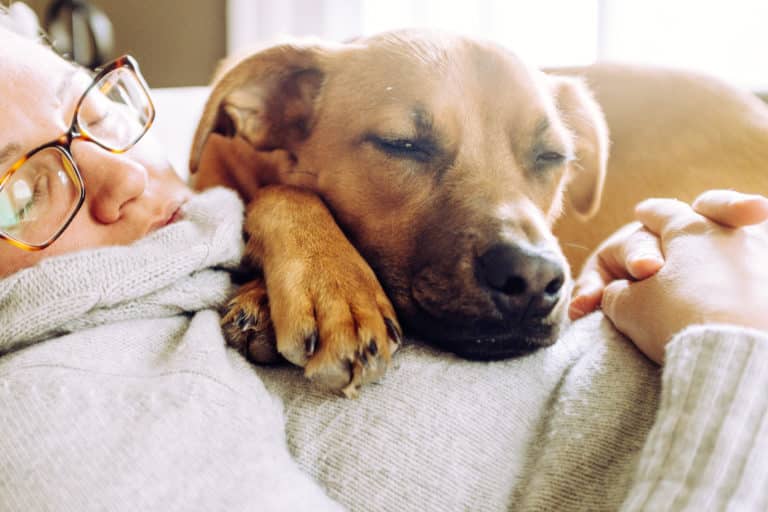
Image by Sal/Flickr, Some Rights Reserved.
We Let Them Go When the Time Has Come
I say this out loud at my peril: my dog hasn’t been to the vet in almost two weeks. The last time he was there, the bill was .25 for a urinary catheterization and an aerobic culture, plus .50 for antibiotics when the results were positive.
The time before that it was for a non-sterile urine sample (which didn’t tell us what we needed to know) and a full physical, with special attention to the abdominal region because after 11 years of only doing his business outdoors he had suddenly taken a liking to a wildly expensive oriental rug.
I discovered this unfortunate new habit early one morning, on my bleary way to the coffee maker, when I stepped in it, barefooted. The same thing happened the next day, in exactly the same place. At the vet’s suggestion I bought a spray bottle of Anti-Icky-Poo, despite reservations about a product named by a moron or a five-year-old. It was supposed to disguise the odor and dissuade his return to the same spot but didn’t work. The next step was rolling up the rugs since at least an accident on a bare wood floor would be easier to clean up.
My annoyance shamed me. For 11 years, Henry, a regal Standard Poodle, had been my devoted companion, as only a dog can be. Now here I was obsessed about vet bills, disgusted to start my day stepping in poop, resentful I had to walk him in the dead of night, and so house-proud that rolled-up rugs were an aesthetic offense. Also, I was surprised at my own surprise that a sick dog was a costly bother.
Last year Henry was diagnosed with liver cancer, when a sonogram revealed a tumor of about one centimeter. Three months later, a second sonogram showed the mass had doubled in size. Removing it meant major surgery, a risky business for a dog this age. There was no way of telling if it had spread to other organs without further invasive procedures.
Assuming I took these next steps, then what? Would I subject a dog whose normal lifespan is 12-14 years to ongoing cancer treatment? I decided I wouldn’t and thus didn’t need a map to a place I wasn’t going.

The plan was the doggy equivalent of palliative care: do only what would keep him comfortable and happy. One example was eschewing routine periodontal care and possible extractions, both requiring anesthesia. If he didn’t have a toothache, why bother? Presuming the tumor would likely at some point put pressure on his abdominal organs, we’d monitor whether he ate well, drank normal amounts of water, had typical bladder and bowel function, and remained alert and frisky.
For a year, but for changing his diet, all was stable. Being a worrying sort, I nevertheless investigated what to do if a dog falls gravely ill when the vet is closed and how to get him there since he’s way too big to carry. All of this information is in a manila folder on my desk marked “DOG.”
The last few months, calm has given way to one canine crisis after another until the current veterinary reprieve, which will end when he’s finished the course of antibiotics. Then we’ll test if the infection is gone. My hunch is “yes,’’ but I’ve been wrong before. And if the next culture is still abnormal, there’s another decision tree. Test for this. Test for that. Sonogram or endoscopy. Maybe nothing at all. This dog has had nine lives already and maybe will have a tenth.
From the day of diagnosis, the vet and all my friends with a lifetime of experience of dogs and their dying, have told me I’d know when Henry’s time was up. His suffering would be obvious and then I’d put him down, they said. But what if it isn’t obvious? I’ve always loved that he didn’t talk, his silence a key component of his peaceful companionship, but now I wish he did.
You don’t euthanize a dog because his digestive system is not tip-top. You don’t euthanize a dog because the rugs are rolled up and company is coming. You don’t euthanize a dog because his medical care is straining the budget. You harshly judge yourself for even thinking about this. You watch and you wait and you wonder how you’ll be sure.
My vet is right around the corner, and Henry and I pass there on our regular morning and evening walks. When they are open for business, through the plate glass windows, he charms whoever is behind the desk to open the door and give him a treat. After hours, when they are dark and shuttered, he sniffs around the concrete foundation or stares imploringly inside.
Maybe he is silently suffering and needs a doctor. Maybe he’s hoping for a treat. Maybe he’s just messing with my mind. The vet tells me poodles are as smart as eight-year-olds. Messing with my mind is something an eight-year-old might do.
Why, you might ask, does this end-of-life muddle surprise me?
Largely it’s because so many suffering elderly people, my late mother among them, comment repeatedly that we are kinder to our pets than to people since we let them go when the time has come. That remark has become a cliché, which usually happens with oft-repeated remarks that are true. But this cliché, I find, watching a dying dog take one step forward and two steps back, is not actually true.
Yes, we have the capacity to put our pets to sleep with a single merciful injection. Yes, it’s legal to do that to animals while assisted suicide for human beings is against the law in the vast majority of states. But for pets and people both, it’s not always clear when the time has come. The process is not always linear. I know Henry is dying. But I haven’t a clue how I’ll know when Henry would be better off dead.

